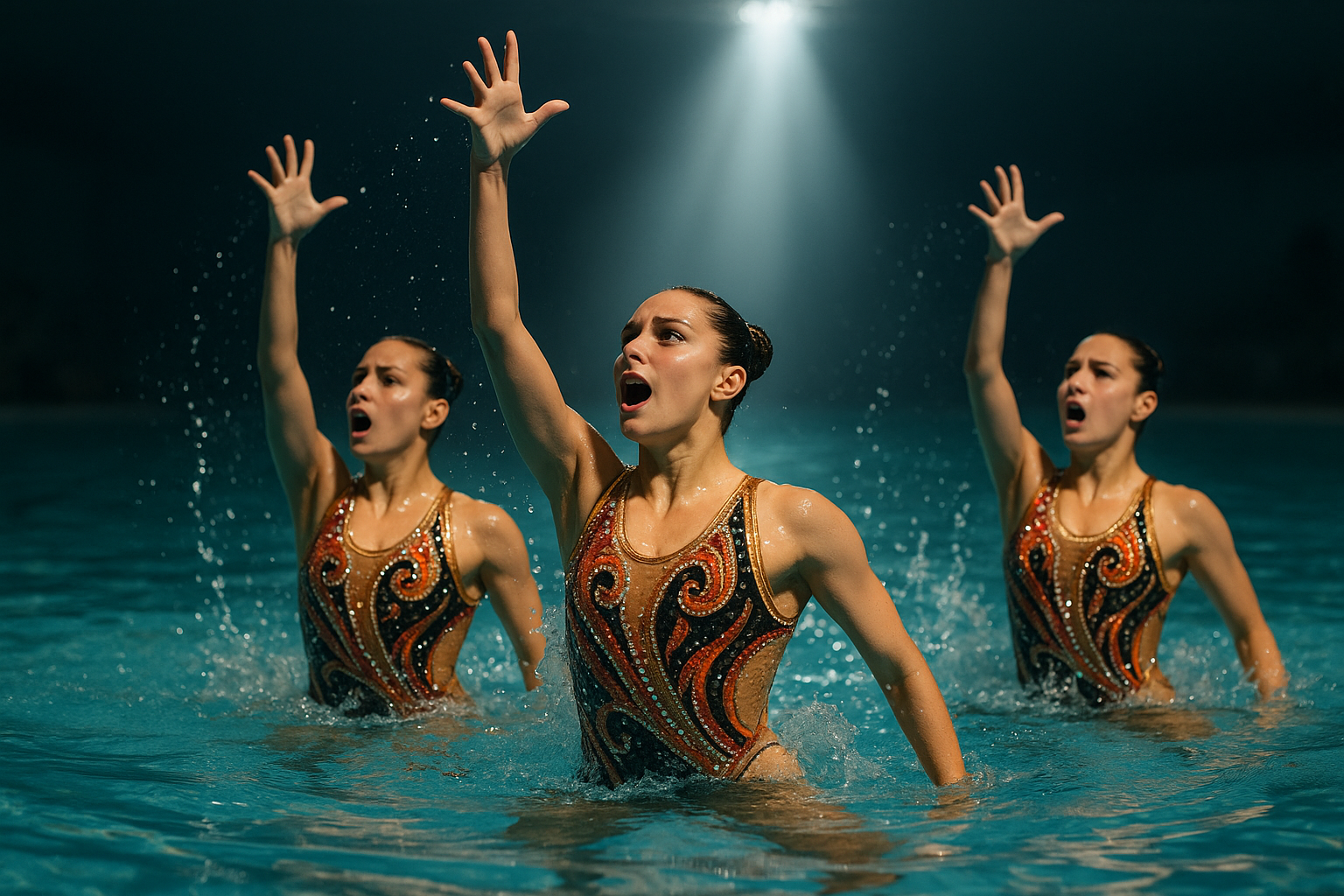Synchronized Swimming: The Aquatic Ballet Transforming Competitive Water Sports
In the world of aquatic sports, a mesmerizing discipline has been making waves, captivating audiences with its blend of athleticism, artistry, and precision. Synchronized swimming, often overlooked in mainstream sports coverage, has quietly evolved into a highly competitive and technically demanding sport. This unique fusion of swimming, dance, and gymnastics challenges athletes to perform intricate routines while suspended in water, pushing the boundaries of human capability and redefining our understanding of aquatic performance.

The Origins of Synchronized Swimming
Synchronized swimming’s roots can be traced back to the early 20th century, with its beginnings in water ballet performances. The sport emerged as a blend of swimming, dance, and acrobatics, initially gaining popularity as a form of entertainment at aquatic shows and exhibitions. In the 1930s, Katherine Curtis, an American swimming instructor, began developing the foundational techniques and movements that would eventually define synchronized swimming as a competitive sport.
The discipline gained international recognition in the 1950s, with the first official competition held in 1954. As the sport evolved, it incorporated elements from various disciplines, including gymnastics, dance, and traditional swimming techniques. This unique combination of skills set synchronized swimming apart from other aquatic sports, attracting athletes with diverse backgrounds and abilities.
The International Swimming Federation (FINA) recognized synchronized swimming as an official discipline in 1952, paving the way for its inclusion in major international competitions. The sport made its Olympic debut as a demonstration event at the 1984 Los Angeles Games, finally achieving full medal status at the 1984 Olympics in Los Angeles.
Technical Mastery and Artistic Expression
At its core, synchronized swimming is a testament to the extraordinary control and strength of its athletes. Performers must execute complex movements while maintaining perfect synchronization with their teammates, all while partially submerged in water. This requires a unique combination of endurance, flexibility, and breath control that few other sports demand.
The technical aspects of synchronized swimming are rigorous and multifaceted. Athletes must master a wide range of skills, including:
-
Eggbeater kick: A specialized treading water technique that allows swimmers to maintain a stable vertical position while keeping their upper bodies above water.
-
Sculling: Precise hand movements that provide propulsion and stability in various positions.
-
Figures: Specific body positions and movements that form the building blocks of routines.
-
Lifts and throws: Acrobatic elements that involve lifting teammates out of the water or propelling them into the air.
-
Underwater work: Extended periods of submerged performance, requiring exceptional breath control and spatial awareness.
These technical elements are combined with artistic expression, choreography, and musicality to create routines that are both visually stunning and technically impressive. Judges evaluate performances based on technical merit, artistic impression, and difficulty, making synchronized swimming one of the most comprehensive and demanding sports in the aquatic realm.
The Physical and Mental Demands of Synchronized Swimming
The physical requirements for synchronized swimmers are extraordinary. Athletes must possess a unique combination of strength, flexibility, endurance, and cardiovascular fitness. Training regimens are intense and varied, often including:
-
In-water training: Several hours of daily pool time focusing on technique, routine practice, and endurance building.
-
Dry-land conditioning: Strength training, flexibility work, and cardiovascular exercises to support in-water performance.
-
Dance and gymnastics: Cross-training to enhance grace, body control, and artistic expression.
-
Breath-holding exercises: Specialized training to increase lung capacity and underwater endurance.
-
Team synchronization drills: Exercises designed to improve timing and coordination among team members.
The mental aspects of synchronized swimming are equally demanding. Athletes must develop exceptional focus, spatial awareness, and the ability to perform under pressure. The sport requires a high level of teamwork and trust, as routines often involve intricate formations and potentially dangerous acrobatic elements.
Furthermore, synchronized swimmers must cultivate a strong sense of musicality and artistic interpretation. They must be able to express emotions and tell stories through their movements, all while maintaining technical precision and synchronization with their teammates.
Evolving Techniques and Innovations
As synchronized swimming has grown as a competitive sport, it has seen significant advancements in techniques, training methods, and performance strategies. Some of the most notable innovations include:
-
Vertical training: The development of specialized apparatus that allows swimmers to practice vertical movements and lifts out of the water, improving strength and technique.
-
Underwater speakers: The introduction of submerged sound systems that enable athletes to hear music clearly while underwater, enhancing synchronization and timing.
-
Advanced breath-holding techniques: The incorporation of freediving methods to increase underwater endurance and performance capabilities.
-
Biomechanical analysis: The use of underwater cameras and motion tracking technology to analyze and refine movements with unprecedented precision.
-
Artistic collaborations: Partnerships with choreographers, composers, and costume designers from other artistic disciplines to elevate the creative aspects of routines.
These innovations have not only improved the technical quality of performances but have also pushed the boundaries of what is possible in the sport. Routines have become increasingly complex and spectacular, with athletes performing feats that would have been unimaginable in the early days of synchronized swimming.
The Global Landscape of Synchronized Swimming
While synchronized swimming has traditionally been dominated by a few powerhouse nations, the sport has seen significant global growth in recent years. Countries such as Russia, China, and Spain have consistently produced top-tier athletes and teams, but emerging programs in nations like Ukraine, Japan, and Canada are challenging the established order.
The sport has also seen efforts to increase inclusivity and diversity. While historically a female-dominated discipline, men’s synchronized swimming has gained traction, with FINA approving men’s participation in the 2015 World Championships. This move has opened up new possibilities for mixed-gender events and has broadened the appeal of the sport.
International competitions have evolved to showcase the sport’s various facets. The Olympic program currently includes duet and team events, while World Championships feature a wider range of categories, including solo technical and free routines, mixed duets, and combination team events. These diverse event formats allow athletes to demonstrate their skills in different contexts and appeal to a broader audience.
Challenges and Future Prospects
Despite its growth and development, synchronized swimming faces several challenges as it looks to the future:
-
Media coverage and public perception: The sport often struggles to gain mainstream media attention, leading to misconceptions about its difficulty and athleticism.
-
Funding and resources: Many national programs face financial constraints, limiting access to advanced training facilities and support systems.
-
Athlete retention: The demanding nature of the sport can lead to early burnout and retirement, challenging the development of experienced performers.
-
Judging controversies: Like many subjective sports, synchronized swimming has faced criticism over scoring inconsistencies and perceived biases.
-
Balancing tradition and innovation: The sport must navigate the fine line between preserving its artistic roots and embracing new technologies and performance styles.
However, the future of synchronized swimming remains bright. The sport continues to attract talented athletes drawn to its unique combination of physical challenge and artistic expression. Efforts to increase male participation and introduce new event formats are expanding its appeal and participant base.
Technological advancements are also opening up new possibilities for training and performance. Virtual reality systems are being explored as tools for visualization and routine planning, while advancements in fabric technology are leading to more hydrodynamic and expressive costumes.
The Impact of Synchronized Swimming on Aquatic Sports
Synchronized swimming’s influence extends beyond its own discipline, impacting the broader world of aquatic sports and physical culture:
-
Cross-training benefits: Many swimmers and divers incorporate elements of synchronized swimming into their training regimens to improve body control and breath-holding capacity.
-
Artistic inspiration: The sport has inspired new forms of aquatic performance and art, influencing everything from competitive diving choreography to water-based theater productions.
-
Water safety awareness: The sport’s emphasis on advanced aquatic skills has contributed to broader water safety education efforts.
-
Inclusive aquatic programming: Synchronized swimming has been adapted for various populations, including seniors and individuals with disabilities, promoting aquatic fitness and therapy.
-
Technical innovations: Advancements in underwater sound systems and pool design for synchronized swimming have benefited other aquatic sports and recreational swimming.
The Cultural Significance of Synchronized Swimming
Beyond its athletic merits, synchronized swimming holds a unique place in popular culture and societal perceptions of sport:
-
Gender dynamics: As one of the few female-dominated Olympic sports, synchronized swimming has played a role in discussions about gender equality and representation in athletics.
-
Artistic-athletic fusion: The sport challenges traditional notions of athleticism by blending physical prowess with artistic expression, broadening the definition of sport.
-
Team dynamics and cooperation: Synchronized swimming exemplifies the power of teamwork and collective performance, offering lessons applicable beyond the pool.
-
Body image and diversity: The sport has grappled with issues of body image and athletic ideals, gradually moving towards greater acceptance of diverse body types and physiques.
-
Cultural exchange: International competitions in synchronized swimming have facilitated cultural exchange and understanding among athletes from diverse backgrounds.
Conclusion: The Aquatic Art Form Pushing Boundaries
Synchronized swimming stands as a testament to the incredible potential of human performance in the aquatic environment. It challenges our perceptions of what is possible in water, combining raw athleticism with artistic grace in a way that few other sports can match. As the discipline continues to evolve, it pushes the boundaries of physical performance, artistic expression, and teamwork.
The future of synchronized swimming lies in its ability to adapt and innovate while maintaining the core elements that make it unique. As training techniques advance, technologies improve, and new generations of athletes bring fresh perspectives to the sport, synchronized swimming is poised to reach new heights of performance and popularity.
For those who witness a synchronized swimming routine, the experience is often transformative. The seamless blend of power and grace, the perfect synchronization of multiple athletes moving as one, and the daring acrobatics performed in and above the water create a spectacle that is both awe-inspiring and emotionally moving.
As we look to the future of aquatic sports, synchronized swimming stands as a shining example of human creativity and physical mastery. It reminds us that even in the most challenging environments, the human body and spirit are capable of creating moments of pure beauty and athletic excellence. In the world of synchronized swimming, every performance is a celebration of what can be achieved when art and athleticism come together in perfect harmony.




